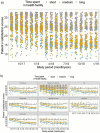Time spent at health facility is a key driver of patient satisfaction, but did not influence retention to HIV care: A serial cross-sectional study in Mozambique
- PMID: 38635537
- PMCID: PMC11025808
- DOI: 10.1371/journal.pone.0299282
Time spent at health facility is a key driver of patient satisfaction, but did not influence retention to HIV care: A serial cross-sectional study in Mozambique
Abstract
Introduction: Patient satisfaction with clinical services can have an effect on retention in HIV care and adherence to antiretroviral therapy. This study assessed patient satisfaction and its association with retention and viral suppression in Zambézia Province, Mozambique.
Methods: Monthly exit interviews with persons living with HIV were completed from August 2017-January 2019 in 20 health facilities; clinical data were extracted from medical records. Regression analyses assessed the effect of satisfaction scores on retention and viral suppression, adjusting for age, sex, education, civil status, time on treatment, and site. Satisfaction scores were correlated with time spent at health facilities using generalized linear regression models.
Results: Data from 4388 patients were analyzed. Overall median satisfaction score was 75% (IQR 53%-84%); median time spent at facilities (from arrival until completion of clinical services) was 2h54min (IQR 1h48min-4h). Overall satisfaction score was not associated with higher odds of retention or viral suppression, but association was seen between satisfaction regarding attention given to patient and respect and higher odds of viral suppression. Patient satisfaction was negatively associated with time spent in facility (Spearman's correlation -0.63). Increased time spent at facility (from 1 to 3 hours) was not associated with lower retention in care (OR 0.72 [95%CI:0.52-1.01] and 0.83 [95%CI: 0.63-1.09] at 6- and 12-months, respectively), nor with a lower odds of viral suppression (OR 0.96 [95%CI: 0.71-1.32]).
Conclusions: Strategies to reduce patient wait times at the health facility warrant continued prioritization. Differentiated models of care have helped considerably, but novel approaches are still needed to further decongest crowded health facilities. In addition, a good client-provider communication and positive attitude can improve patient satisfaction with health services, with an overall improved retention.
Copyright: © 2024 De Schacht et al. This is an open access article distributed under the terms of the Creative Commons Attribution License, which permits unrestricted use, distribution, and reproduction in any medium, provided the original author and source are credited.
Conflict of interest statement
The authors have declared that no competing interests exist.
Figures






References
-
- UNAIDS. UNAIDS Core Epeidemiology Slides 2021. Geneva2022 [Available from: https://www.unaids.org/en/resources/documents/2022/core-epidemiology-slides.
-
- MOH. Relatório Anual das Actividades Relacionadas ao HIV/SIDA. Relatório Anual 2021. 2022.
-
- Gostin L, Hodge J, Valentine N, Nygren-Krug H. WHO Health and Human Rights Working Paper Series No 2. The Domains of Health Responsiveness: A Human Rights Analysis. Geneva; 2003.
MeSH terms
LinkOut - more resources
Full Text Sources
Medical

